
Karrabina benthamiana is a species of rainforest trees, growing naturally in north–eastern New South Wales and south–eastern Queensland, Australia. They have common names including red carabeen, leather jacket, brush mahogany, red bean, pink marara and brush mararie. This species used to be placed in the genus Geissois as Geissois benthamiana.

Rhodosphaera is a genus of plants in the family Anacardiaceae. The genus includes a single species, Rhodosphaera rhodanthema, which is a rainforest tree of eastern Australia. It grows in sub tropical rainforests and also in the drier form of rainforests. The natural range of distribution is from the Macleay River, New South Wales to Maryborough in south east Queensland. Common names include deep yellowwood, yellow cedar and tulip satinwood.

Polyscias murrayi, known as the pencil cedar, is a very common rainforest tree of eastern Australia.

Cryptocarya foveolata, known as the mountain walnut is a rainforest tree growing at high altitude in eastern Australia. Despite the common name, it belongs to the laurel family.

Polyscias sambucifolia, commonly known as elderberry panax or small basswood, is a species of plant native to eastern Australia.

Trochocarpa montana, the mountain tree heath, is an Australian shrub or small tree. It occurs at high altitude from the Barrington Tops to the Dorrigo region of northern New South Wales.

Arytera divaricata, known as the gap axe, coogara, coogera or rose tamarind is a forest tree of eastern Australia. An attractive plant with glossy pale and limp new leaves. It grows in fairly dry situations, often in littoral rainforests and monsoon forest.

Dysoxylum mollissimum subsp. molle, the red bean or Miva mahogany, is a rainforest tree in the family Meliaceae. It occurs in tropical, sub-tropical and littoral rainforests in eastern Australia, as far southwards as north-eastern New South Wales. Also occurs in Malesia and the south-western Pacific Islands. In Australia it is distributed from the Bellinger River in New South Wales in the south, to the wet tropics of north-eastern Queensland. The specific epithet mollissimum is from the Latin, meaning "very soft", describing the soft hairy leaflets. A signposted red bean tree may be seen near the car park of Victoria Park Nature Reserve in north-eastern New South Wales.

Elattostachys nervosa, known as the green tamarind or beetroot tree is a common rainforest tree of eastern Australia. Found in all types of rainforest, growing from Paterson, New South Wales in the south to Gympie in south east Queensland. The name Elattostachys refers to "little spikes", a flower feature of other plants in this genus. Nervosa refers to the prominent leaf venation. Beetroot Tree refers to the beetroot red leaves of the new growth.
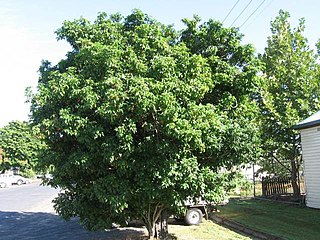
Harpullia pendula, known as the tulipwood or tulip lancewood is a small to medium-sized rainforest tree from Australia. The tree's small size, pleasant form and attractive fruit ensures the popularity of this ornamental tree. The range of natural distribution is from the Bellinger River in northern New South Wales to Coen in tropical Queensland. Tulipwood occurs in various types of rainforest, by streams or dry rainforests on basaltic or alluvial soils. In tropical and sub tropical rainforest. Often seen as a street tree, such as at St Ives, New South Wales.
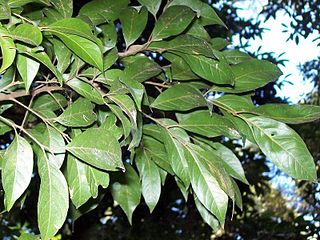
Sarcopteryx stipata, known as the steelwood, is a rainforest tree of eastern Australia occurring from the Bulga Plateau and Comboyne Plateau north west of Taree, New South Wales as far north as Fraser Island off the coast of south eastern Queensland. It grows in sub tropical rainforest but sometimes occurs in warm temperate rainforests on poorer soils. It is a member of the soap berry family. The generic name Sarcopteryx translates to "fleshy wing", as the fruit can be wing shaped. Stipata means "surrounded". The common name steelwood refers to the very tough, hard and heavy timber.

Mischocarpus pyriformis, known as the pear fruited tamarind is a rainforest tree of eastern Australia. Occurring from Seal Rocks, New South Wales to as far north as Cooktown in tropical Queensland. The sub species found in New South Wales is Mischocarpus pyriformis subsp. pyriformis.

Pomaderris aspera is a plant from eastern and southern Australia. Mostly seen south of the Barrington Tops in New South Wales to as far south as Wilsons Promontory and Cape Otway on the mainland. Also occurring in Tasmania. Scattered individuals are found in northern New South Wales to as far north as Bunya Mountains National Park in Queensland.
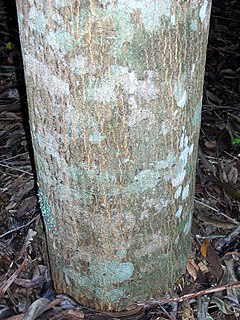
Owenia cepiodora is a medium to large Australian tree in the family Meliaceae. It occurs in the rainforests of north eastern New South Wales and adjacent areas in Queensland. The habitat is mostly the drier Hoop Pine rainforests along the state border. Only small regrowth trees remain, as it was heavily logged in earlier times. Its status is now considered vulnerable with a ROTAP rating of 2VCi.
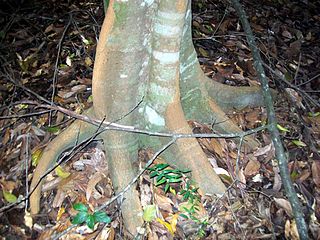
Endiandra muelleri is a rainforest tree of eastern Australia. Its habitat is in warm temperate rainforests on poorer soils. Distributed from the Allyn River in the Barrington Tops region in the south to Kroombit Tops to the north in central Queensland.

Pseudoweinmannia lachnocarpa is a rainforest tree of eastern Australia. Common names include rose marara, mararie, scrub rosewood and red carabeen. The species name lachnocarpa is from the Greek, referring to the "woolly fruit". The genus name refers to the similarity of another genus, Weinmannia, after the German eighteenth century pharmacist J.W. Weinmann.

Atalaya multiflora, known as the broad leaved whitewood, is a rare and endangered rainforest tree of the soapberry family native to eastern Australia.
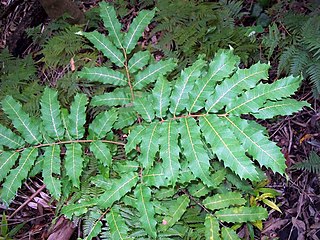
Cupaniopsis newmanii is a rainforest plant in the soapberry family. It is native to eastern Australia. The common name is long-leaved tuckeroo. A rare plant, with a ROTAP listing of 2RC-. The habitat sub tropical rainforest ranging from Mullumbimby in New South Wales to Gympie in south-eastern Queensland.

Vesselowskya rubifolia, commonly known as southern marara, red ash, mountain marara or Dorrigo southern marara, is a species of flowering plant in the family Cunoniaceae plant and has a restricted distribution in eastern New South Wales. It is a shrub or small tree with compound leaves with three or five leaflets with serrated edges, and small whitish flowers arranged along a raceme.

Elattostachys xylocarpa, known as the white tamarind or short-leaf beetroot is a common rainforest tree of eastern Australia. Found in the drier rainforests, which are based on volcanic soils. From as far south as the Orara River in northern New South Wales to Bowen in tropical Queensland. The name Elattostachys refers to "little spikes", a flower feature of other plants in this genus. xylocarpa refers to the hard woody fruit.




















